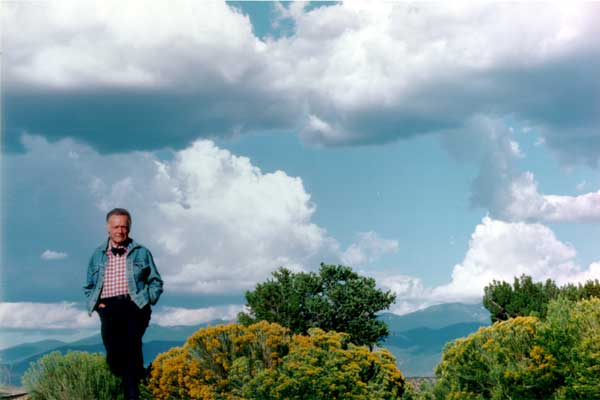
Eric Sloane, c.1983, in La Tierra, near Santa Fe, New Mexico, USA
Eric Sloane was born, Everard Jean Hinrichs on February 27, 1905 in New York City, New York, to a well-to-do family. Early on, he took up an interest in art, spending many boyhood hours with neighbor and noted font inventor, Fredrick Goudy (Goudy Type). From Goudy, at an early age, he learned to hand paint letters and create signs.
Some of his first clients included aviation pioneers flying out of Roosevelt Field, Long Island. Many of those flyers insisted he paint the identifying marking on their planes. In exchange for teaching him to paint, Wiley Post himself, taught the young Hinrichs to fly. After his first flight the young man fell in love with clouds and the sky, themes that would be central to his work for the rest of his life. Among his early clients was Amelia Erhardt, who bought his first cloud painting. Said to be the finest cloud painter of his generation, his largest cloud painting graces an entire wall of the Smithsonian Air and Space Museum in Washington DC.
After a falling out with his family, young Sloane ran away at age fourteen to become an itinerant sign painter. He worked his way across America, painting signs on barns, buildings and stores, all the time gathering images of a country in expansion. He had many interesting adventures. One of his most notable stays was with the Taos Pueblo Indian Tribe, just north of Santa Fe, New Mexico.
A prolific member of the Hudson River School of painting, it is generally accepted that Eric Sloane was a artistic genius. Over his lifetime Sloane wrote thirty eight books. It is estimated that he created nearly 15,000 paintings over his lifetime, mostly oil on masonite. He painted one almost every day, often before lunch, striving to do better than the day before. Later in his life, he bought back or traded for some of his earlier work, which he destroyed by fire, contending it was inferior.
While restoring a Connecticut farmhouse in the early 1950's he began to identify with the Early American settlers. He first moved to the Lake Candlewood area, then to Merryall, CT near New Milford and in 1956 he moved to Warren, where he kept a home until 1985. It was at a Warren Library book sale that he is said to have discovered Noah Blake's diary, an original account of New England farm life in 1805. With Sloane's unique illustrations and commentary the diary became the framework for Sloane's most successful book, Diary of an Early American Boy: Noah Blake 1805.
In 1975 Sloane built a home in La Tierra near Santa Fe, New Mexico, "Las Nuves" (The Clouds). From these two comfortable residences, "Mr. Americana", spent most of his later life preserving the practical architecture and stoic lives of the first European settlers, in oil paints and in writing.
Fascinated by weather, The Farmer's Almanac and the early American farmer's ability interpret "weather signs", Sloane is credited with being the first television weatherman, having come up with the idea of having farmers from all over New England call in their weather observations to a Dumont, New York TV station where they could be broadcast to the regional audience. He penned several useful books on the subject.
Sloane is also credited with being the foremost authority on Early American rural architecture and Early American tools. His many books of paintings and drawings, and especially his "A Museum of Early American Tools", are considered the most important historical source works on the subjects. The Sloane Stanley Museum in Kent, Connecticut houses Sloane's own personal collection of Early American tools, as well as an exact replica of his painting studio. "A Reverence for Wood" is an invaluable resource to scholars of old growth timber in New England.
In his seminal Americana work, "Spirts of '76", he published his famous distillation of his philosophy,"Declaration of Self Dependence", a harbinger of the renewed concept of personal responsibility in 2nd millenium.
Shortly before the release of his last book, "Eighty", on his way to meet his wife for lunch, Eric died instantly of a heart attack in New York, on March 5th, 1985, on the steps of the Plaza Hotel. Friends say it was the only time he was ever late. He is buried in Kent, Connecticut at the Sloane Stanley Museum.
Sloane was married a total of five times. Little is known by this biographer of his first four wives. His last, and longest life partner, was Miriam Francis Alicia Carman, known by all as, "Mimi", born Brussels May 8, 1925, and sadlly, passed away in late 2011, in Santa Fe, New Mexico. Mimi was an exceptionally classy act. It was my pleasure to be her house guest from time to time at her beatiful adobe home on Circle Drive. She was a wonderful friend.
Eric's spirit lives on today as if he's determined to keep the invincible Early American Spirit alive. One has only to read one of his books or view his paintings to be touched by his unfathomable human compassion.
Eric's friends and site visitors are invited to contribute to his legacy with their comments, observations, remembrances and questions, which will be published on the message page.